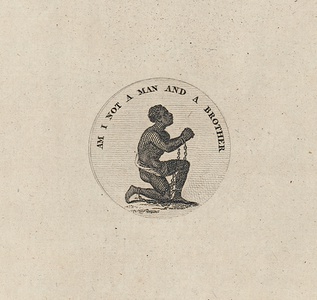| Method | Copper engraving |
| Artist | Thomas Holloway after Josiah Wedgwood and Henry Webber |
| Published | Printed for J. Johnson, St. Paul's Church-Yard. 1795. |
| Dimensions | Image 28 x 28 mm, Sheet 141 x 209 mm |
| Notes |
A small scale print depicting Wedgwood's anti-slavery medallion from the third edition of Erasmus Darwin's celebrated poem, The Botanic Garden. The image, created by Wedgwood as part of anti-slavery campaign in 1787, shows a black man in chains on one knee. His hands are grasped together in a plea, the text above reads Am I not a Man and a Brother. The cameos from which this print was taken became the most identifiable image of the 18th century abolitionist movement. The actual design of the cameo was probably done by either William Hackwood or Henry Webber who were modellers at the Wedgwood factory. Thomas Clarkson, a leading abolitionist wrote of the design, "ladies wore them in bracelets, and others had them fitted up in an ornamental manner as pins for their hair. At length the taste for wearing them became general, and thus fashion, which usually confines itself to worthless things, was seen for once in the honourable office of promoting the cause of justice, humanity and freedom". Thomas Holloway (1749-1827) was a British painter, reproductive engraver and publisher of his own work. Born in London, he entered the Royal Academy Schools as an engraver in 1773 and exhibited his work between 1777 and 1816. Josiah Wedgwood (1730 – 1795) was an English potter, entrepreneur and abolitionist. Born in Burslem, Staffordshire, Wedgwood was the youngest child of the potter Thomas Wedgwood, the Wedgwood family having been potters since the 17th century. After an apprenticeship with his older brother, he formed a partnership with another potter and went into business himself establishing the now world famous Wedgwood Company. Science and scientific processes were key to Wedgwood's pottery-making and he was so successful that other companies and makers found their trade affected. His many innovations include development of a green glaze still popular today, the perfection of creamware, and the invention of the pyrometer. He is credited as a pioneer of modern marketing, specifically utilising marketing techniques such as direct mail, money-back guarantees, free delivery, and illustrated catalogues. Wedgwood was a prominent slavery abolitionist, mass-producing cameos depicting the seal for the Society for Effecting the Abolition of the Slave Trade and having them widely distributed, the design became a popular and celebrated image of the abolitionist movement. His daughter Susannah was the mother of Charles Darwin. Henry Webber (1754–1826) was an English sculptor and modeller. Webber is most known for his work for The Wedgwood Company at Etruria, where he became chief sculptor in 1785, a position he held until 1806. Webber was also the designer of the monument to David Garrick in the Poet's Corner in Westminster Abbey. This had been begun by John Hickey but Hickey had died during the project and it was passed to Webber to complete. Condition: Light foxing to sheet, not affecting image. |
| Framing | unmounted |
| Price | £125.00 |
| Stock ID | 53334 |

